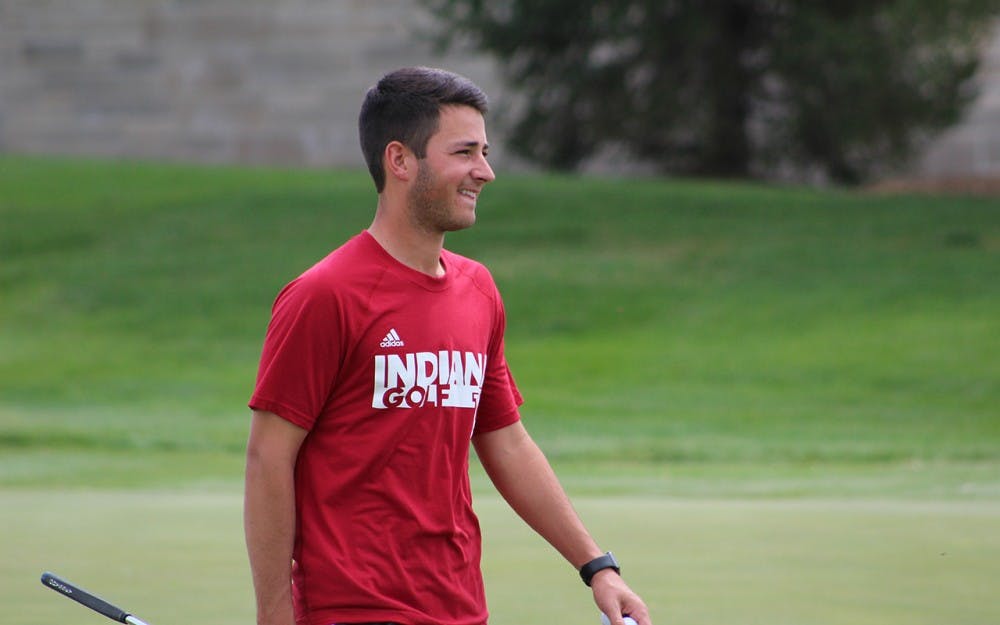Jake Brown didn’t have his own set of clubs until April 2010, the spring of his eighth grade year. Brown’s dad, Jim, got him a set of clubs for his birthday.
Brown, now a sophomore golfer for IU, had done what most middle schoolers tend to do: whatever their friends do. His friends quit baseball, and so did he.
Up until that point, the Browns had been a baseball family. Jake and his three older brothers had hit from plenty of batter’s boxes but not so many tee boxes. Jake had never even swung a golf club.
Their dad had been a member at Crooked Stick Golf Club near their home in Indianapolis since the late 1990s, but he had yet to introduce the sport to his kids.
While Jake’s older brothers — Jimmy, Joey and Johnny — continued to play baseball, Jake took up his father’s sport. Jim had been a member for nearly a decade at the time, but Jake said he could’ve counted the number of rounds his dad had played at Crooked Stick on two hands.
Once Jake started playing, Jim had a reason to play again. Jake got serious about golf soon after he first swung a club, so his dad set him up with swing coach John Dal Corobbo, who has worked with Jake ever since.
When Brown first reached out to IU Coach Mike Mayer as a high school sophomore, Mayer told him he didn’t have room on his team. With such limited space and Brown’s little experience, IU didn’t give him a serious look until the summer after his junior year.
“Jake was a latecomer, a kid nobody really knew of,” Mayer said.
Brown had wedged his way into a national tournament the previous summer with the help of Tony Pancake, the director of golf at Crooked Stick. Brown didn’t have the résumé to make the field, but Pancake pulled strings to get him in, and Brown played like he deserved to be there. He made the cut that weekend in front of an audience of more than 50 college coaches.
Mayer said he recalls this as the first time he noticed Brown.
Brown made such an impression that, despite his lack of roster space, Mayer contacted coaches from Northern Illinois and Ball State to make sure Brown’s raw talent found a collegiate home. Both coaches expressed interest and Ball State even offered a walk-on spot to Brown.
The following summer, Brown played in a number of national events, including the Western Junior Championship at Meridian Hills in Indianapolis. After seeing him play once again, Mayer decided to make room. He offered Brown a walk-on spot shortly after.
Mayer said the jump between junior and collegiate golf is indescribable, and due to Brown’s inexperience, Mayer redshirted the freshman from Carmel High School.
“He didn’t want to redshirt, but I felt that he was a perfect candidate,” Mayer said. “He needed that year. It gave him an idea of what it takes to play at this level.”
Brown said his redshirt season gave him another year to mature. After all, he had only played golf for four years. After his redshirt year, Brown finished his freshman season as IU’s lowest scorer and top player. He posted the team’s lowest scoring average of 74.29.
“It’s a blessing in disguise to have that year there because I learned so much,” Brown said. “My game got so much better, which allowed me to have the year I had last year.”
The redshirt season allowed Brown to fine tune his game, and it gave him an opportunity to continue to learn from a former Carmel teammate, senior Andrew Havill. Havill and Brown grew up down the street from each other, and when Brown decided to pick up golf, Havill picked up Brown.
“He was the one playing with me every day, practicing, helping me every way he could,” Brown said “I looked up to him a lot growing up.”
Havill and Brown’s relationship changed from that of family friends to a discipleship when golf entered the picture. Havill’s dad was a golf pro, and Havill had been around the sport his whole life. Brown said as a quiet leader, Havill simply provided an example to follow.
“I had a lot of people in my ear about what to do and how to play the game of golf because I started so late,” Brown said. “I wouldn’t say I picked his brain on things, but to be able to watch what he did and how he played and composed himself on the golf course is what I modeled my game after.”
Just as Havill provided a model for Brown on the course, Brown said he hoped to provide a model for younger players like freshman Brock Ochsenreiter.
Brown was host to Ochsenreiter on his official tour, and the two have roomed together on multiple occasions at tournaments, he said. They talk about the intricacies of the game and how their roles on the team continue to change.
“He’s used to being the best player on his team, and now he’s with five guys on his team who are all similar in terms of the caliber of their play,” Brown said. “We need people on the team who bring people together, and that’s what I’ve been trying to do this year.”
Brown led the Hoosiers in scoring all of last season after redshirting as a freshman, and this year he finds himself in a different role, but a role making him an important player for the Hoosiers heading into the Big Ten Championship. He sits in the third spot in the lineup despite his midseason struggles, struggles that dissipated last weekend.
He said his confidence is at a season-high following his 3-under 69 last Sunday at Purdue. Brown will have the chance to build momentum for the postseason this weekend at Ohio State.






